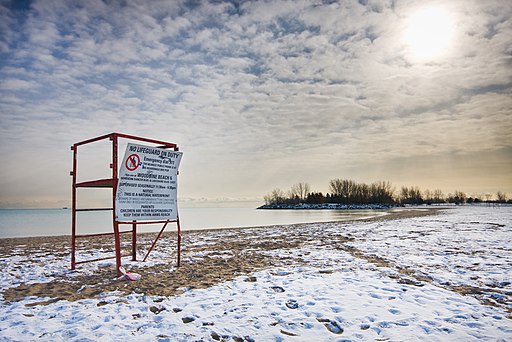 |
| Photo by Benson Kua from Toronto, Canada |
I've never bought the progression of logic imposed on so many of these "summer reading lists": that books which are read in the summer must a) be read on the beach and b) constitute a vacation (within a vacation!) from the heavier, morose themes that apparently dominate the books we read when we're out of direct sunlight.
As if by virtue of warmer days, all readers want breezy and easy, delicious and dishy, nothing to make them think too hard about themes of mortality or, say, the reality of melting polar ice caps, rising tides...and vanishing beaches.
Or winter.
Summer makes it easy to be taken in by your own carefree delusion, and takes credit for your happiness. But be warned. As the narrator in Icelandic novelist Sjón's book, From the Mouth of the Whale, observes:
In the perpetual light of high summer one has leisure to contemplate the terrible black chill that is the season we call winter, and all the evil that it brings. After such thoughts one sits and turns one's face to the sky, closing one's eyes and letting the blueness fill one with the illusion that it will always be so, or at the most the sky will flush like the cheek of a bashful boy but never grow dark again.
In this spirit of disillusionment and reluctant embrace of the inevitable winter of the soul, here's a summer reading list that, if anything, reminds you how nice it is to be lying on your back in the sand...while you still can.
 Barren Grounds: The Story of the Tragic Moffatt Canoe Trip, by Fred "Skip" Pessl
Barren Grounds: The Story of the Tragic Moffatt Canoe Trip, by Fred "Skip" PesslIn 1955, Arthur Moffatt led a group of college students on an expedition to the Barren Lands of Arctic Canada, a trip that has since been described as "an excellent example of how not to conduct a canoe trip." The exhaustion of the adventurers as they made their way, their dwindling food supplies, and the harsh conditions forced them to be less cautious, which led to the fatal mistake that caused two canoes to capsize in the frigid waters. Moffatt, the leader, died of exposure, leaving these college kids to find a way to safety. Barren Grounds comprises passages from the journals of two of the young party members, as well as entries from Moffatt's own journal, in which we all learn a few hard lessons in recreational travel.
 At the Point of a Cutlass: The Pirate Capture, Bold Escape, and Lonely Exile of Philip Ashton, by Gregory N. Flemming
At the Point of a Cutlass: The Pirate Capture, Bold Escape, and Lonely Exile of Philip Ashton, by Gregory N. FlemmingThis book has beaches and palm trees, but imagine you've been exiled to an island in the Caribbean, having escaped a pirate ship where you'd been held captive for months. This is the vivid portrait of fisherman Philip Ashton in the 18th-century "golden age of piracy," a time when threat of being kidnapped and tortured by pirate captains like Edward Low was anything but rollicking good fun on the high seas. If you were Ashton, that is. A Publishers Weekly starred review says Flemming "adds a welcome depth to the history of piracy with this engaging and harrowing account of 'America’s real-life Robinson Crusoe.'"
Killer Show: The Station Nightclub Fire, America's Deadliest Rock Concert, by John Barylick
It's all there in the title. The tragedy of the roadhouse fire in West Warwick, RI, in February 2003, set off by a lethal combination of the heavy-metal act's pyrotechnics and the flammable foam sound insulation on the club's walls, killing 100 people in less than 10 minutes, was in fact a crime. And Barylick, a lead attorney who prosecuted wrongful-death cases related to it, writes of his painstaking search for evidence to hold the band, the club owners, promoters, building inspectors, and others fully accountable for the cause of the fire and its aftermath. A horribly riveting read.
 Night Flight to Dungavel: Rudolf Hess, Winston Churchill, and the Real Turning Point of WWII, by Peter Padfield
Night Flight to Dungavel: Rudolf Hess, Winston Churchill, and the Real Turning Point of WWII, by Peter PadfieldFor decades there has been no clear answer to why Hitler's #2, Rudolf Hess, in May of 1941, flew a German fighter across the channel and crash-landed in Scotland. He was imprisoned in England, later tried at Nuremberg, and imprisoned at Spandau in Berlin, where he would remain until his death (possibly suicide) at age 93. Padfield investigates the many mysteries surrounding Hess' flight: what actually happened, whether he acted alone, the role that Churchill and British MI6 played, and why this episode was a real turning point in the war.
 Fetch the Devil: The Sierra Diablo Murders and Nazi Espionage in America, by Clint Richmond
Fetch the Devil: The Sierra Diablo Murders and Nazi Espionage in America, by Clint RichmondIn 1938, Hazel Frome and her 23-year-old daughter, both San Francisco socialites, were on a cross-country drive when their car broke down in El Paso, TX. Making the most of a bad situation, they passed over the border into Juarez for some shopping and dining, and a week later their battered bodies were found in the Texas desert, with few clues as to circumstances of their abduction, days-long torture, and brutal murders. Richmond relies on long-forgotten archives and declassified FBI files to draw a haunting connection to a Nazi spy ring that operated through El Paso—and was run by spymasters at the German consulate in San Francisco.
 A Murder in Wellesley: The Inside Story of an Ivy-League Doctor's Double Life, His Slain Wife, and the Trial that Gripped the Nation, by Tom Farmer & Marty Foley
A Murder in Wellesley: The Inside Story of an Ivy-League Doctor's Double Life, His Slain Wife, and the Trial that Gripped the Nation, by Tom Farmer & Marty FoleyIt became a national story in 1999, when the investigation of the murder of Mabel Greineder in well-heeled Wellesley, MA, turned its focus on her husband, Dirk Greineder, a prominent physician and family man suddenly revealed to have been leading a double life involving prostitutes, pornography, and trysts solicited through the Internet. Farmer and Foley revisit this chilling story, interviewing key figures and showing how investigators pieced together a case against Greineder, culminating in one of the most dramatic courtroom spectacles in recent memory.
Deluge: Tropical Storm Irene, Vermont's Flash Floods, and How One Small State Saved Itself, by Peggy Shinn
Such a sinister summer reading list should conclude with a book that opens at the golden end of a typically delightful Vermont summer. But by the close of August 2011, in the southern gulf region, hurricane season had already begun, and yielded a storm that charted a path up the Atlantic coastline, through New York, and into northern New England. Downgraded to a tropical storm by the time it reached Vermont, Irene's massive store of rainwater was no less severe. And in a matter of a few hours, on August 28, the rains that the mountains absorbed were wrung out like water from a sponge, turning babbling village brooks into raging torrents, washing out roads, destroying bridges, and crippling access to and from several towns throughout the state. Thousands were left homeless. As the storm passed and waters finally subsided, a national emergency declared, Vermonters didn't wait for outside help. Townsfolk pulled one another from the wreckage and quietly performed every manner of good deed to save lives and rebuild communities. This book captures the heartbreak and the heroism.



No comments:
Post a Comment
Note: Only a member of this blog may post a comment.